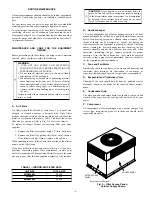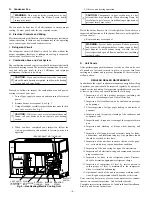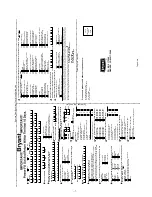
G.
Condenser Fan
WARNING:
Do not poke sticks, screwdrivers, or any
other object into revolving fan blades. Severe bodily
injury may result.
The fan must be kept free of all obstructions to ensure proper
cooling. Contact your dealer for any required service.
H.
Electrical Controls and Wiring
Electrical controls are difficult to check without proper instrumen-
tations; therefore, if there are any discrepancies in the operating
cycle, contact your dealer and request service.
I.
Refrigerant Circuit
The refrigerant circuit is difficult to check for leaks without the
proper equipment; therefore, if inadequate cooling is suspected,
contact your local dealer for service.
J.
Combustion Area and Vent System
The combustion area and vent system should be inspected visually
before each heating season. The normal accumulation of dirt, soot,
rust, and scale can result in loss of efficiency and improper
performance if allowed to build up.
CAUTION:
If your unit makes an especially loud noise
when the main burners are ignited, shut down the heating
section and call your dealer.
Proceed as follows to inspect the combustion area and power-
venting system of your unit:
1. Turn off gas supply to your unit and then turn off electrical
power.
2. Remove burner access panel. See Fig. 1
3. Using a flashlight, carefully inspect the burner areas for dirt,
soot, rust, or scale. See Fig. 2
CAUTION:
If dirt, soot, rust, or scale accumulations are
found, call your dealer an do not operate your heating
section.
4. When you have completed your inspection, follow the
start-up procedures in this manual to restore your unit to
operation.
5. Observe unit heating operation.
CAUTION:
Components in heat section may be hot
after unit has been started up. When observing flame, be
careful not to get close to or touch heating components or
personal injury may result.
Watch the burner flame to see if it is bright blue. If you observe a
suspected malfunction or if the burner flames are not bright blue,
call your dealer.
6. Replace burner access panel.
WARNING:
System under pressure. Relieve pressure
and recover all refrigerant before system repair or final
unit disposal to avoid serious injury or death. Use all
service ports and open all flow-control devices, including
solenoid valves.
K.
Unit Panels
After performing any maintenance or service on the unit, be sure
all panels are fastened securely in place to prevent rain from
entering unit cabinet and to prevent disruption of the correct unit
airflow pattern.
REGULAR DEALER MAINTENANCE
In addition to the type of routine maintenance you might be willing
to perform, your unit should be inspected regularly by a properly
trained service technician. An inspection (preferably each year, but
at least every other year) should include the following:
1. Inspection of all flue product passages—including the
burners, heat exchangers, and flue collector box.
2. Inspection of all combustion- and ventilation-air passages
and openings.
3. Close inspection of all gas pipes leading to and inside of
your unit.
4. Inspection and, if required, cleaning of the condenser and
evaporator coils.
5. Inspection and, if required, cleaning of the evaporator drain
pan.
6. Inspection and cleaning of blower wheel housing and
motor.
7. Inspection of all supply-air and return-air ducts for leaks,
obstructions, and insulation integrity. Any problems found
should be resolved at this time.
8. Inspection of the unit base to ensure that no cracks, gaps,
etc., exist which may cause a hazardous condition.
9. Inspection of the unit casing for signs of deterioration.
10. Inspection of all electrical wiring and components to assure
proper connection.
11. Inspection for leaks in the refrigerant circuit. Pressure-
check to determine appropriate refrigerant charge.
12. Inspection of compressor oil level by service person to
ensure proper oil level is maintained in the compressor
when it is installed and running.
13. Operational check of the unit to determine working condi-
tions. Repair or adjustment should be made at this time.
Your servicing dealer may offer an economical service contract
that covers seasonal inspections. Ask for further details.
Complete service instructions can be found in the unit Installation,
Start-Up and Service Instructions.
Fig. 4—Gas Heating/Electric Cooling Unit
INDUCED DRAFT MOTOR MOUNT
VENT HOOD
IN SHIPPING
LOCATION
FLUE
COLLECTOR
BOX
BLOWER
HOUSING
BURNER
RACK
MOUNTING
SCREW
ROLLOUT
SWITCH
—4—


























